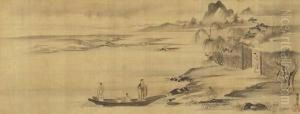Kano Naonobu Paintings
Kano Naonobu was a Japanese painter of the Kano school, one of the most prominent schools of Japanese painting, which was founded by Kano Masanobu in the 15th century and continued to influence Japanese art for over 400 years. Naonobu was born in 1607, during the Edo period, a time when the Kano school was the official painting school of the Tokugawa shogunate, and the artists of this school largely dominated the Japanese art scene with their works commissioned by the shogunate and other feudal lords.
Naonobu was the younger brother of Kano Tanyu, who is considered one of the foremost painters of the Kano school. Under the tutelage of his brother and within the environment of the Kano artistic tradition, Naonobu developed a strong command of the Kano style, which was characterized by a blend of realism and stylization, with an emphasis on brushwork and the use of Chinese themes and techniques adapted for Japanese tastes.
During his career, Kano Naonobu contributed to the legacy of the Kano school by producing works that often incorporated themes from nature, such as landscapes and bird-and-flower paintings. His works were also influenced by Zen Buddhism and often carried a sense of simplicity and a focus on the essential elements of the subject matter. Naonobu's paintings were marked by their elegance and often contained an underlying sense of spirituality, which was a characteristic of many Kano school artists.
Naonobu's career was unfortunately rather short, as he died in 1650 at the relatively young age of 43. Despite his early death, his works have been recognized for their quality and refinement, contributing to the enduring reputation of the Kano school. Naonobu's paintings can be found in various collections, including temples and museums, and they continue to be studied and appreciated for their historical significance and artistic merit.

